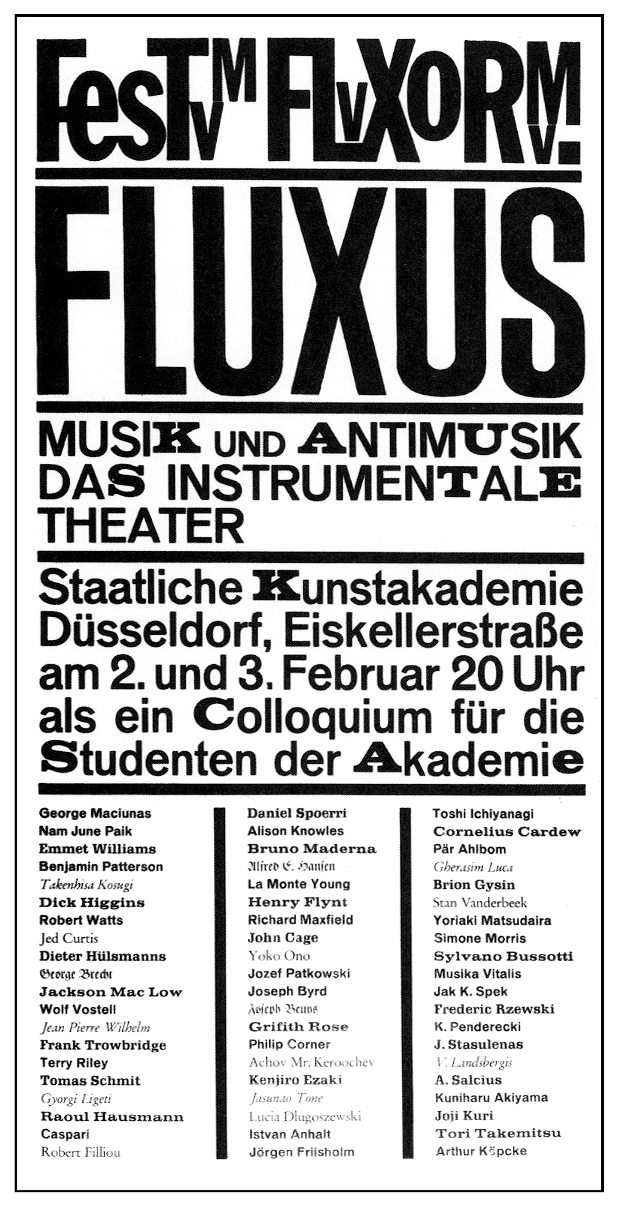|
Fluxus
Fluxus was an international, interdisciplinary community of artists, composers, designers, and poets during the 1960s and 1970s who engaged in experimental performance art, art performances which emphasized the artistic process over the finished product. Fluxus is known for experimental contributions to different artistic media and disciplines and for generating new art forms. These art forms include intermedia, a term coined by Fluxus artist Dick Higgins; conceptual art, first developed by Henry Flynt, an artist contentiously associated with Fluxus; and video art, first pioneered by Nam June Paik and Wolf Vostell. Dutch gallerist and art critic Harry Ruhé describes Fluxus as "the most radical and experimental art movement of the sixties".. 1979. ''Fluxus, the Most Radical and Experimental Art Movement of the Sixties'' Amsterdam: Editions Galerie A. They produced performance art, performance "events", which included enactments of scores, "Neo-Dada" noise music, and time-based w ... [...More Info...] [...Related Items...] OR: [Wikipedia] [Google] [Baidu] |
George Maciunas
George Maciunas (; ; November 8, 1931 Kaunas – May 9, 1978 Boston, Massachusetts) was a Lithuanian American artist, art historian, and art organizer who was the founding member and central coordinator of Fluxus, an international community of artists, architects, composers, and designers. He is most famous for organizing and performing in early Fluxus Happenings and Festivals, for his Fluxus graphic art work, and for assembling a series of highly influential Fluxus artists' multiples. Early life His father, Alexander M. Maciunas, was a Lithuanian architect and engineer who had trained in Berlin, and his mother, Leokadija, was a Russian-born dancer from Tiflis affiliated with the Lithuanian National Opera Mr. Fluxus, p. 338 and, later, Aleksandr Kerensky's private secretary, helping him complete his memoirs. After fleeing Lithuania to avoid being arrested by the advancing Red Army in 1944, and living briefly in Bad Nauheim, Frankfurt, Germany, initially under Nazi co ... [...More Info...] [...Related Items...] OR: [Wikipedia] [Google] [Baidu] |
Dick Higgins
Dick Higgins (15 March 1938 – 25 October 1998) was an American artist, composer, art theorist, poet, publisher, printmaker, and a co-founder of the Fluxus international artistic movement (and community). Inspired by John Cage, Higgins was an early pioneer of electronic correspondence.Oxford Dictionary of Modern and Contemporary Art, p. 239 Higgins coined the word intermedia to describe his artistic activities, defining it in a 1965 essay by the same name, published in the first number of the ''Something Else Newsletter''. His most notable audio contributions include '' Danger Music'' scores and the ''Intermedia'' concept to describe the ineffable inter-disciplinary activities that became prevalent in the 1960s. Life Dick Higgins was the son of Carter Chapin Higgins and Katherine Huntington Bigelow. He was born in Cambridge, England in 1938 into a rather rich family, due to his father owning Worcester Pressed Steel in Worcester, Massachusetts. He grew up with a brother an ... [...More Info...] [...Related Items...] OR: [Wikipedia] [Google] [Baidu] |
Alison Knowles
Alison Knowles (born 1933) is an American visual artist known for her installations, performances, soundworks, and publications. Knowles was a founding member of the Fluxus movement, an international network of artists who aspired to merge different artistic media and disciplines. Criteria that have come to distinguish her work as an artist are the arena of performance, the indeterminacy of her event scores resulting in the deauthorization of the work, and the element of tactile participation. She graduated from Pratt Institute in New York with an honors degree in fine art. In May 2015, she was awarded an honorary doctorate degree by Pratt. In the 1960s, she was an active participant in New York City's downtown art scene, collaborating with influential artists such as John Cage and Marcel Duchamp. During this time she began producing event scores, or performances that rework the everyday into art. Knowles's inclusion of visual, aural, and tactile elements sets her art apart from ... [...More Info...] [...Related Items...] OR: [Wikipedia] [Google] [Baidu] |
